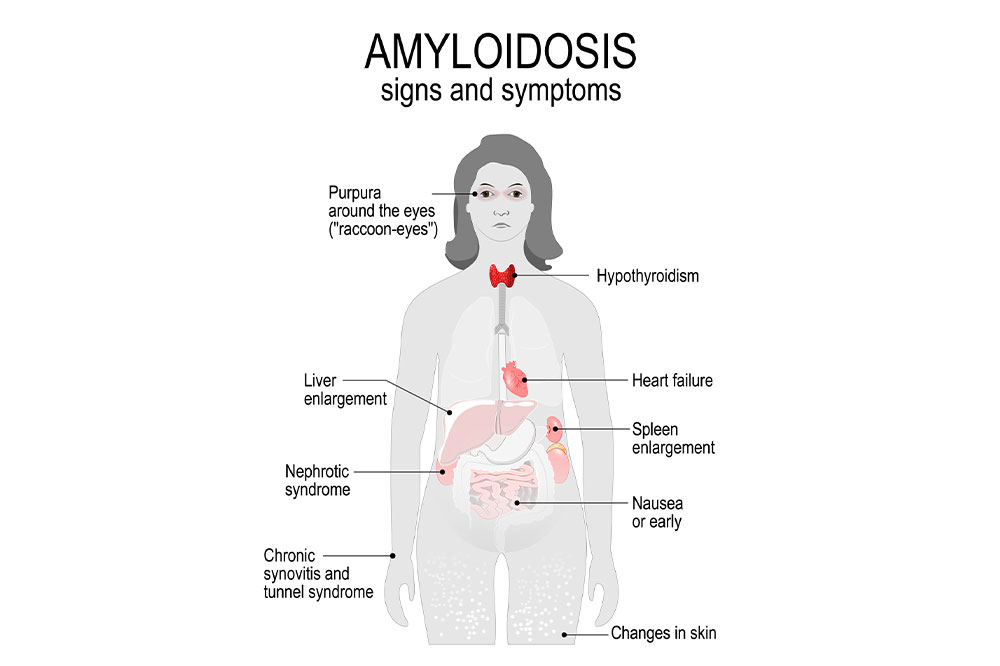
Causes, types, symptoms, and risk factors of amyloid disease
Amyloid is a disease characterized by an abnormal protein called amyloid build-up. This protein is normally not found in the body but is produced due to other types of proteins. Amyloid interferes with the way organs function and affects their shape. This can lead to a significant change in the system. This illness can even lead to organ failure. Read to know more about the causes, types, and symptoms of this disease.
Causes
While many types of proteins can lead to amyloid deposits, there are specific kinds linked to the abnormal growth of amyloid. The two most common proteins that contribute to amyloidosis include light chain (AL) and transthyretin (ATTR) amyloidosis.
Light Chain (AL)
These are also called antibodies created by white blood cells and plasma cells present in the bone marrow. In this type of amyloidosis, a group of plasma cells develops light chains in a generous amount, which collect and turn into amyloid fibrils. The fibrils then find a place in an organ, and the most common organs affected by amyloid are the kidneys and the heart. Other organs prone to this illness include the stomach, large intestine, liver, nerves, and skin.
Transthyretin (ATTR)
The protein transthyretin is the main culprit of this rare type of amyloidosis. It changes its shape and form to turn into fibrous clumps. These clumps can deposit themselves into organs or peripheral nerves, which may significantly impact the way they function. This type of amyloidosis may be caused due to gene mutations or due to aging. Depending on where the amyloids collect, doctors can diagnose which type of amyloidosis one has. However, amyloid can also spread throughout the body and affect multiple organs at once.
Types of amyloidosis
AL amyloidosis (immunoglobulin light chain amyloidosis)
Also known as primary amyloidosis, this is the most common type. This type of amyloidosis occurs due to the abnormal growth of antibodies in the bone marrow. It is usually linked with blood cancer and can affect the kidneys, heart, liver, intestines, and nerves.
AA Amyloidosis
AA stands for the amyloid type A protein responsible for this type of amyloidosis. This is the second type of amyloidosis associated with the chronic inflammatory disease called rheumatoid arthritis, Crohn’s disease, or ulcerative colitis. While it mostly affects the kidneys, it can also affect the digestive tract, liver, and heart.
Dialysis-related amyloidosis
This type affects people who have been on dialysis for about five years or more. This type commonly affects the elderly. The cause behind this type is deposits of beta-2 microglobulin in the blood or tissues.
Organ-specific amyloidosis
This type affects the organ where the protein deposits. This may affect the skin (cutaneous amyloidosis). It can affect the brain in very rare cases as some deposits are linked to Alzheimer’s disease.
Symptoms of amyloidosis
Depending on the organs affected, the type of amyloidosis may vary, and so will the symptoms.
Kidney and bladder
Kidneys and the bladder are some of the most common organs affected. The patient may experience less frequency of urination, excessive bubbles in the urine, and waking up at night to urinate.
Stomach or intestines
When amyloidosis affects the stomach or intestines, the patient can suffer from poor appetite, bloating, excessive gas, constipation, or diarrhea.
Heart and lungs
These patients find it difficult to breathe and experience palpitations, chest pain, and fatigue associated with the respiratory system.
Head and neck
Lightheadedness, dizziness, an enlarged tongue, and purple-colored eyelids are some common symptoms of this type of amyloidosis.
Arms and legs
Patients with this type may experience swelling in the feet or legs, weakness or numbness, or a burning sensation in peripheral neuropathy. Weak fingers and toenails are also a sign of amyloidosis.
Risk factors of amyloidosis
Age: People aged 60 to 70 may be prone to this disease more than young people.
Gender: Amyloidosis is common amongst men compared to women.
Family history: If immediate family members have a history of amyloidosis, you may be at the risk of developing it. A type of amyloidosis is passed down the family through genes.
Kidney dialysis: Varied types of proteins may tend to deposit during dialysis, which may cause abnormal proteins to build up in the blood. However, with the latest dialysis technology, the chances of these deposits are less.
Diagnosis
If one experiences any of the signs or a combination, it’s wise to get tested before the illness aggravates. There are many ways to diagnose amyloidosis, including bone marrow biopsy, kidney biopsy, heart biopsy, fat pad biopsy, blood sample, urine collection, echocardiogram or Electrocardiogram (EKG), an MRI, or a cardiac nuclear scan.




